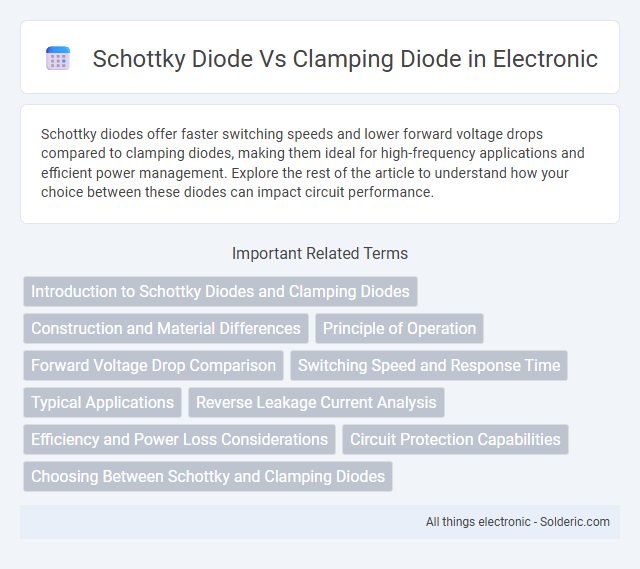Schottky diodes offer faster switching speeds and lower forward voltage drops compared to clamping diodes, making them ideal for high-frequency applications and efficient power management. Explore the rest of the article to understand how your choice between these diodes can impact circuit performance.
Comparison Table
| Feature | Schottky Diode | Clamping Diode |
|---|---|---|
| Function | Rectifies current with low forward voltage drop | Protects circuits by limiting voltage spikes |
| Forward Voltage Drop | Typically 0.15 - 0.45 V | Typically 0.7 V (Silicon diode) |
| Switching Speed | Very fast (nanoseconds) | Depends on diode type; generally fast |
| Material | Metal-semiconductor junction (usually silicon) | Silicon p-n junction diode |
| Application | Power rectifiers, RF applications, fast switching circuits | Voltage spike protection in inductive loads, signal clamping |
| Leakage Current | Higher than standard diode | Low leakage current |
| Reverse Recovery Time | Very low (Less than 5 ns) | Varies, generally higher than Schottky diode |
Introduction to Schottky Diodes and Clamping Diodes
Schottky diodes are semiconductor devices characterized by low forward voltage drop and fast switching speed, making them ideal for power rectification and high-frequency applications. Clamping diodes, on the other hand, are used to prevent voltage spikes by limiting voltage to a safe level, protecting circuits from transient overvoltage conditions. Understanding the electrical characteristics and application roles of Schottky versus clamping diodes is crucial for optimizing circuit design and enhancing electronic device reliability.
Construction and Material Differences
Schottky diodes consist of a metal-semiconductor junction, typically using materials like platinum silicide or molybdenum silicide on an n-type silicon substrate, resulting in low forward voltage drop and fast switching speed. Clamping diodes are usually constructed with a p-n junction made of silicon, designed to protect circuits by limiting voltage spikes through a higher forward voltage compared to Schottky diodes. The fundamental material difference impacts their electrical characteristics, where Schottky diodes excel in speed and efficiency, while clamping diodes provide robust voltage protection in transient conditions.
Principle of Operation
A Schottky diode operates based on the metal-semiconductor junction, allowing low forward voltage drop and fast switching due to majority carrier conduction. In contrast, a clamping diode is used to prevent voltage spikes by shunting excess voltage to ground or supply, protecting sensitive circuits. Your design choice depends on whether you need high-speed rectification or voltage spike protection.
Forward Voltage Drop Comparison
Schottky diodes typically exhibit a lower forward voltage drop, ranging from 0.15 to 0.45 volts, compared to clamping diodes, which usually have a forward voltage drop around 0.7 volts. This lower forward voltage in Schottky diodes results in higher efficiency and reduced power loss in high-speed switching and power rectification applications. Clamping diodes, designed primarily for voltage spike suppression, prioritize robustness over minimal voltage drop.
Switching Speed and Response Time
Schottky diodes offer significantly faster switching speeds and lower response times due to their metal-semiconductor junction, making them ideal for high-frequency applications. Clamping diodes, typically silicon-based, exhibit slower switching speeds and longer response times because of their p-n junction structure. Choosing a Schottky diode can enhance Your circuit's efficiency when rapid switching and quick transient response are crucial.
Typical Applications
Schottky diodes are commonly used in applications requiring fast switching and low forward voltage drop, such as power rectification, RF circuits, and voltage clamping in high-frequency environments. Clamping diodes serve primarily to protect sensitive electronic components by limiting voltage spikes in circuits like relay driver protection, signal line voltage clamping, and transient voltage suppression. Your circuit design benefits from choosing a Schottky diode for efficiency in power conversion and a clamping diode for robust voltage protection.
Reverse Leakage Current Analysis
Schottky diodes exhibit significantly higher reverse leakage current compared to clamping diodes due to their low forward voltage drop and metal-semiconductor junction structure. The elevated leakage in Schottky diodes can lead to increased power dissipation and reduced efficiency in high-temperature environments. Your design must consider these leakage characteristics when selecting a diode for protecting circuits against voltage spikes.
Efficiency and Power Loss Considerations
Schottky diodes offer higher efficiency and lower power loss compared to clamping diodes due to their low forward voltage drop, typically around 0.2 to 0.3 volts, which minimizes conduction losses in high-speed switching applications. Clamping diodes, designed primarily for voltage spike suppression, generally have higher forward voltage drops, resulting in increased power dissipation and reduced efficiency during continuous conduction. Choosing a Schottky diode can improve your circuit's overall energy efficiency and thermal management by reducing heat generation in power-sensitive environments.
Circuit Protection Capabilities
Schottky diodes offer superior circuit protection capabilities due to their low forward voltage drop and fast switching speed, minimizing voltage spikes and reducing power loss in transient conditions. Clamping diodes effectively protect circuits by limiting voltage to a predefined level, preventing overvoltage damage during inductive load switch-off or ESD events. Both diode types enhance circuit reliability, but Schottky diodes are preferred for high-frequency applications, while clamping diodes excel in strict voltage clamping scenarios.
Choosing Between Schottky and Clamping Diodes
Choosing between Schottky and clamping diodes depends on the application requirements such as switching speed, voltage drop, and protection needs. Schottky diodes offer low forward voltage drop (typically 0.2 to 0.3 volts) and fast switching, making them ideal for high-frequency circuits and power rectification. Clamping diodes prioritize voltage spike protection by safely shunting transient voltages, but they typically have higher forward voltage and slower response compared to Schottky diodes.
Schottky diode vs Clamping diode Infographic

 solderic.com
solderic.com